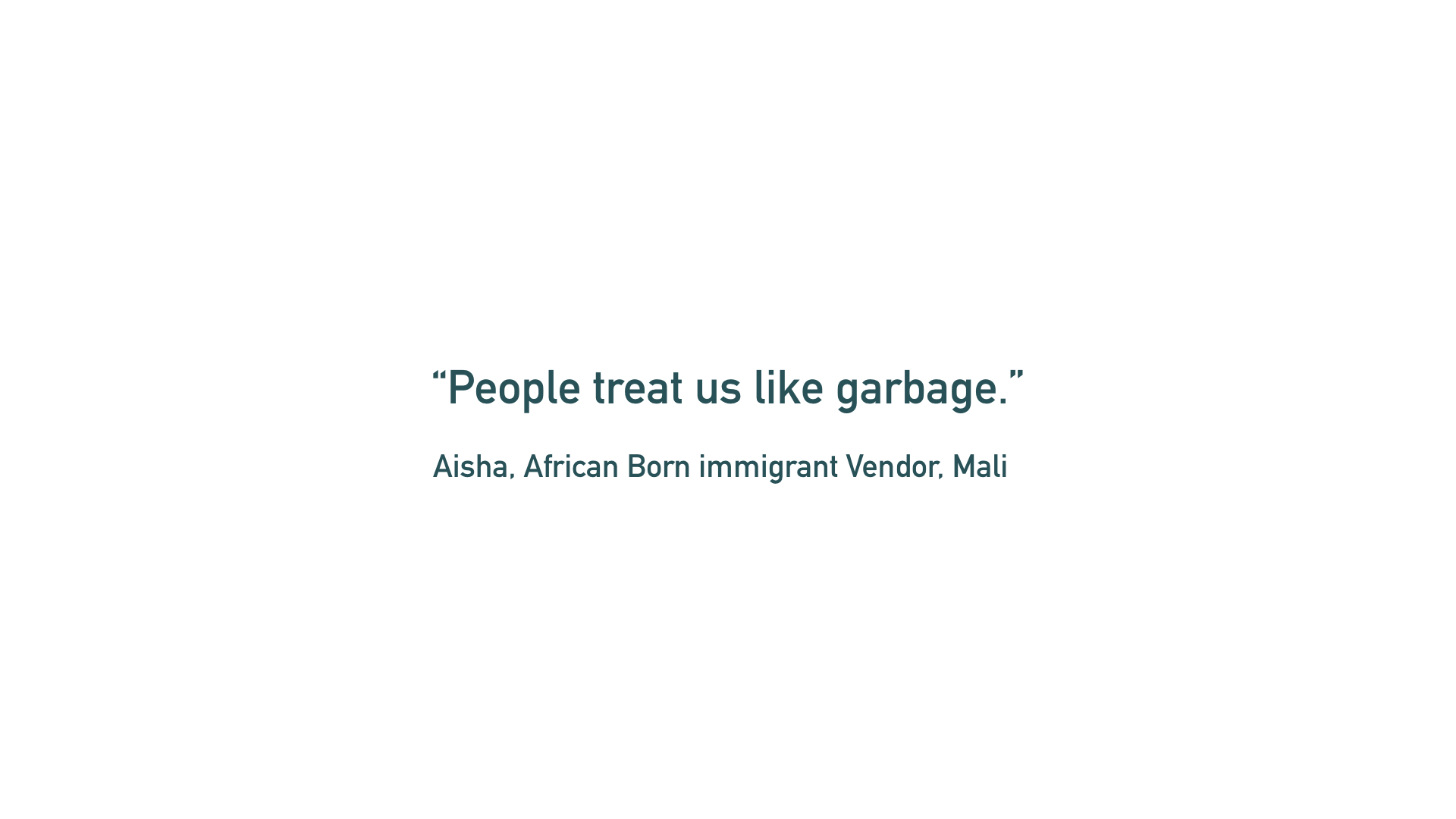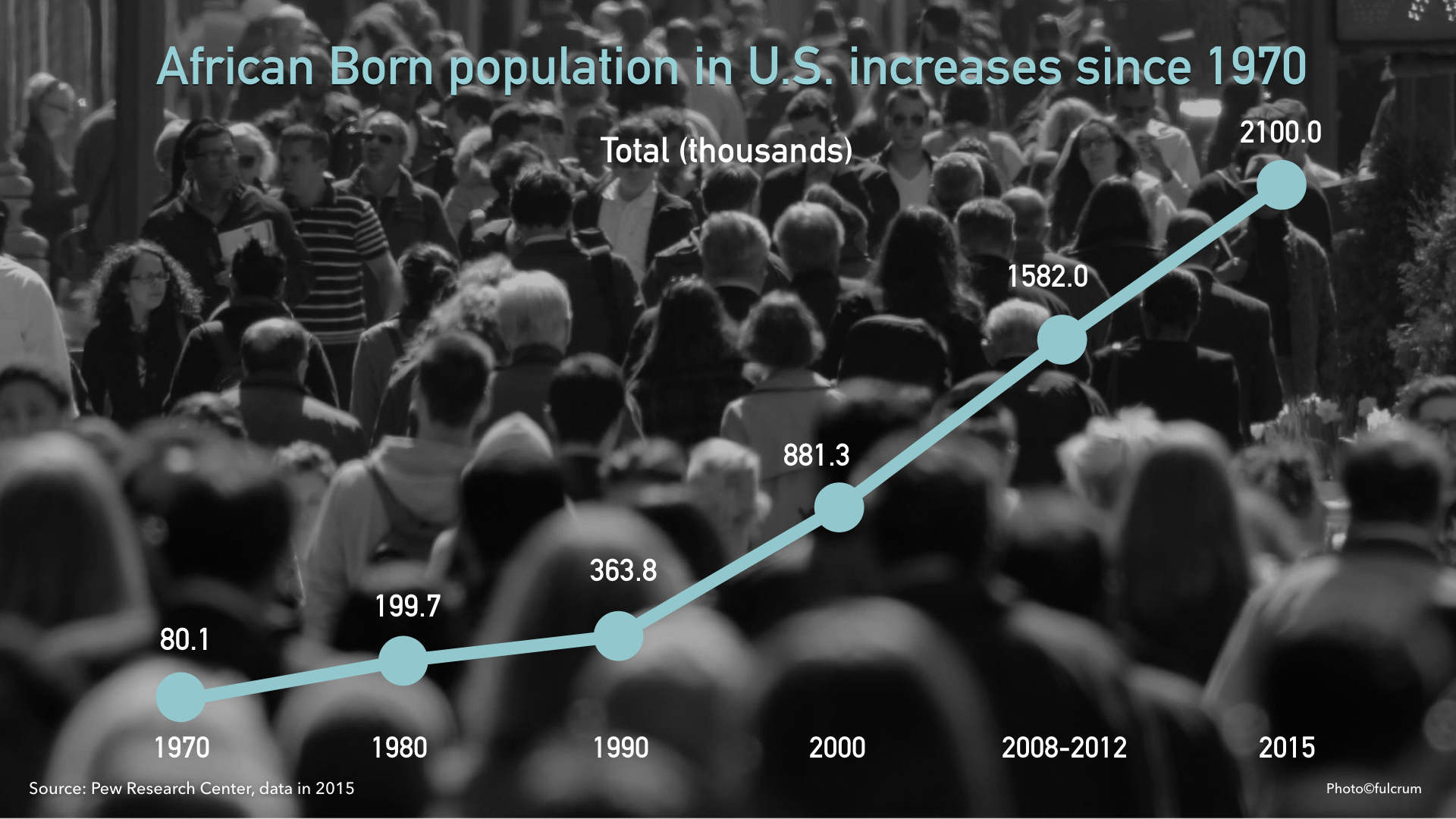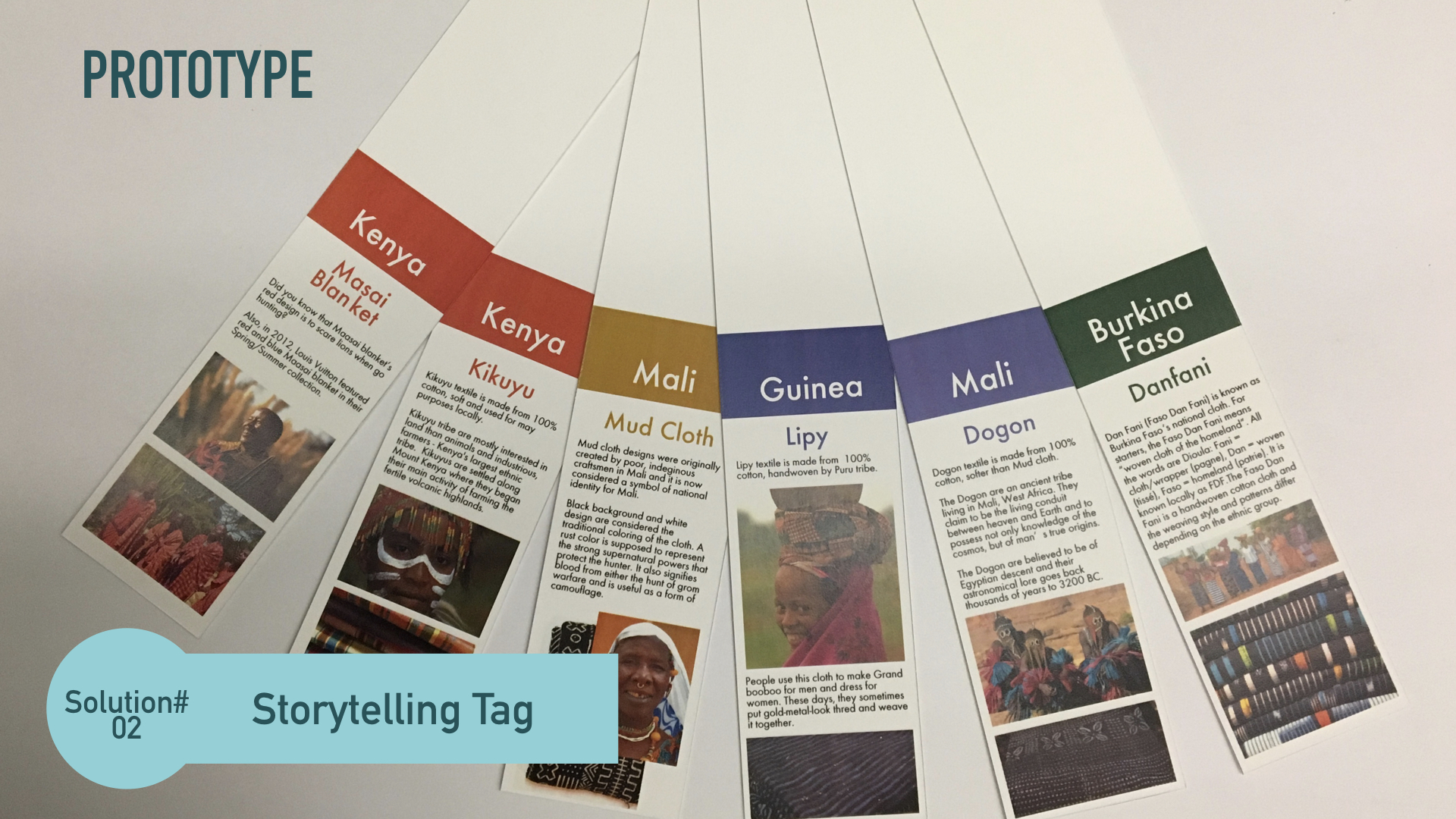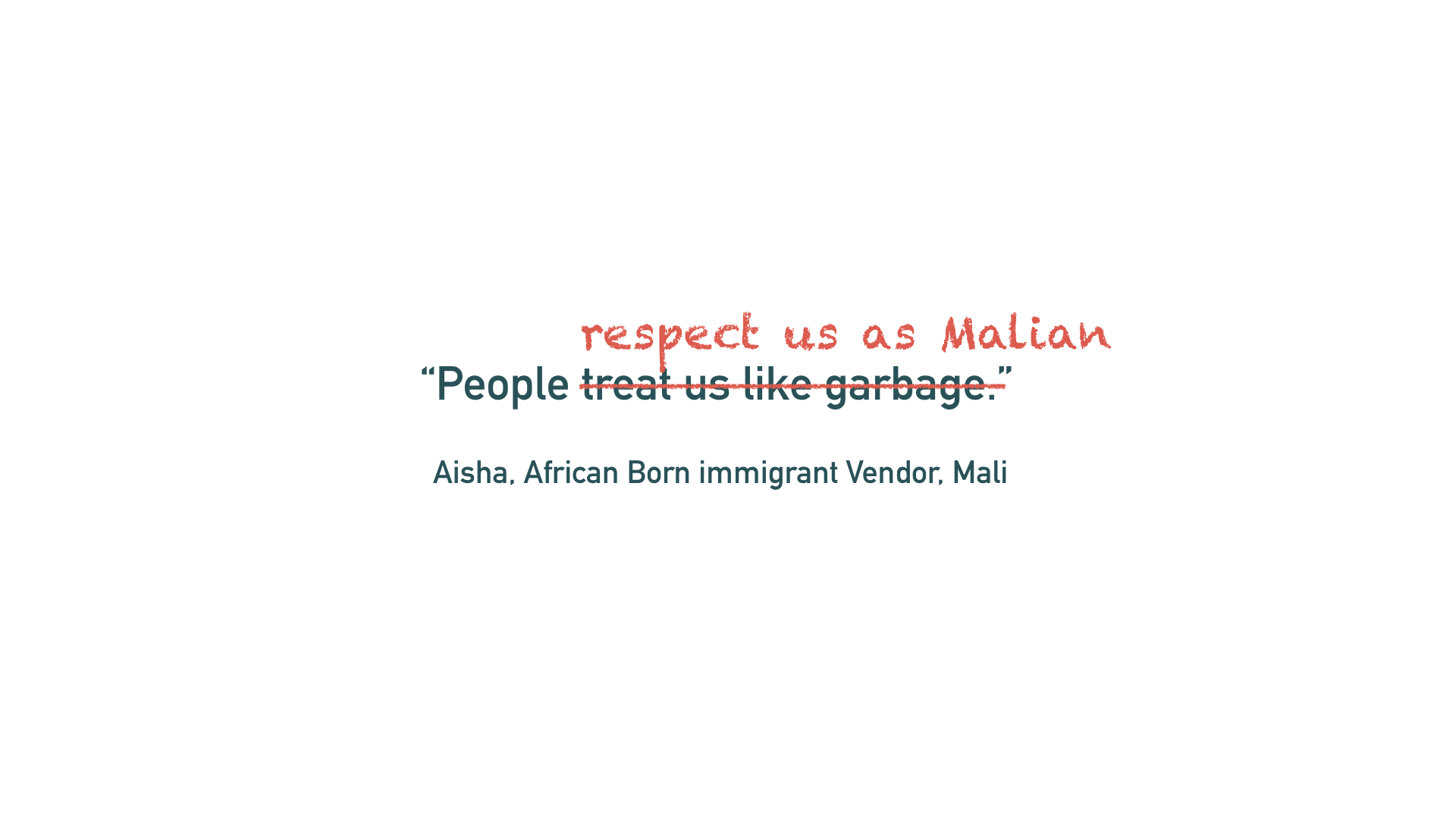h.woven
2017 - 2018 New York
Ethnographic Design Research thesis project at School of Visual Arts, MFA Design for Social Innovation
Thesis Advisor: Benedetta Piantella Simeonidis
The foreign-born population from Africa has grown rapidly in the United States during the last 40 years. However, being underrepresented in society makes it difficult to know who they are and their cultural roots. My thesis project h.woven addresses the unintended chasm between African-born immigrant vendors and their customers in their new home. This is a first step to create a Shared Future in a Fractured World through their rich, indigenous stories. I partnered with Yara African Fabrics LLC. and Murid Fashion in Malcolm Shabazz Harlem Market in New York City to prototype the storytelling tools.
Task: Design Researcher, Ethnographic Researcher, Branding Designer, Illustrator, Logo Designer, Presentation Designer and Process Book Designer.
Background
This is a quote from a vendor named Aisha, an African Born immigrant who sells African print fabrics and cloths in Malcolm Shabazz Harlem Market in New York. What does this quote really mean?
There are many factors —the consistent discrimination of Black people, and the current immigrant policies in the United States —but the biggest issue is that they are not totally humanized in this society. The reason why Aisha feels this way, is because the society doesn’t validate her cultural values.
Through Aisha’s story, I understood that there is an“unintended disconnection.”
According to the World Economic Forum in Davos, the world is fractured into small communities. Globalization is the rapid increase in cross-border economic, social, technological exchange under the conditions of capitalism. However, the community is still not connected globally. Through this project, I am going to talk to you about how we can alleviate this unintended disconnection by using the story of traditional textiles and overcome “otherness”.
Situation: The African born immigrant population has grown significantly in the United States over the past forty years. This growth is 26 times more than in 1970. However, They are known very little, underrepresented in society.
Question: How can we provide an opportunity to African born immigrant vendors to tell stories about the products to alleviate their underrepresentation?
Ethnographic research
To understand the situation of African born immigrants in the city, I went to Harlem, a place that attracts the community. On my visit there, I observed many vendors selling traditional African textiles which is the source of income among those immigrants. With my interest in the field, I focused on understanding these vendors.
Learnings through research
Through research, I observed that traditional craft vendors and their customers are not having meaningful conversations about the product, and the transactions are very dry. If this situation continued, customers will lose an important opportunity to learn a lesser known culture that can cause an unintended disconnection in society. Because of no interaction between customers and vendors, there is an unintended disconnection. And this unintended disconnection is negatively contributing to the underrepresentation of African culture in the society.
“I don’t like it when customers just come and buy. I like to have a human communciation.”
Moctar, African Born Immigrant Vendor from Mali, President of Yara African Fabrics LLC.
Ideas for solution
Based on the conversation with my user Moctar, I built a couple of tangible storytelling tools that facilitates vendors to have meaningful conversations with customers about their culture. I believe that such tools are the starting point to alleviate an unintended disconnection in society.
Prototype #01
The biggest learning was: when the tools required extra action for vendor or customer, they do not interact. So, I went back to the shop space to understand customer and vendor’s journey, and see what could be the point of intervention in the journey. As you can observe through the journey of both customer and vendor in the shop (Upper left slide), the point of intersection between the journeys is “packaging.” Then I created the storytelling package (Upper right slide).
“This package inspires me to share my own story, an Afro-Haitian one, and a history of my own.”
Haitian, User tested at Brooklyn Museum
User test #01
Based on the user journey, I discussed with the vendor and created this “Storytelling package” so that while the vendor is cutting textiles, a customer can take a look at it and learn about cultural stories. I realized this prototype created a strong interest in interaction from a potential customer (Upper photo).
Prototype #02
And I also tried this one with another vendor. This tool is called “the Storytelling tag”. Designed for a Vendor-Designer from Senegal selling handwoven traditional textiles in Malcolm Shabazz Harlem Market. His shop name is Murid Fashion, and he is passionate about telling indigenous stories. The booth in this market place is really small, so his space is tightly packed and there’s no place to put anything, there’s not even enough space to stand. So I tried to come up with a tool that fits his needs of storytelling in a cramped space.
User test #02
This tool was user tested at Murid Fashion.
“More than 10 textile business persons were really interested in the tool and I had meaningful conversations with them.”
DamE Diouf, African Born immigrant Vendor, From Senegal
Possible future of this project
In terms of next steps, it would be amazing to develop an app that creates these storytelling tags easily as it shows as mock-up image. When this app is created and launched, my current users who are African Born immigrant vendors will be able to use this app to take pictures or use local photos, type the stories directly that they wanna tell. And this app will automatically create this kind of tag that can be exported to a JPEG, and then they will be able to print out these by themselves to create their own tags!
Collaboration
For now, I secured the collaboration with an Airbnb African culture tour guide in Harlem, led by Bunmi Davis. She told me she would love to use my Storytelling package in her tours.
Final notes
I expect my project will get more people to respect lesser known or underrepresented cultures. And I expect that there will be less Unintended disconnection in the society. And in the near future, I would love to hear Aisha saying, “People respect us as Malian.”, by weaving Hearts, Hands and Humans.
Thank you so much for reading up to here. If you wish knowing the entire process in detail, I invite you to see Process book.
(Written in May 2018)














